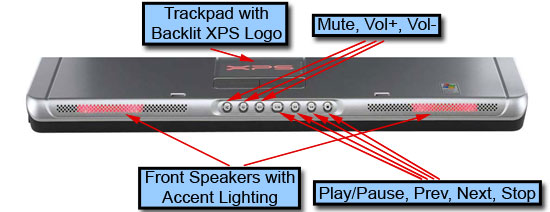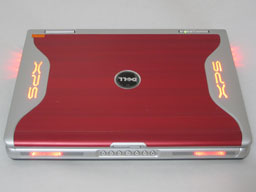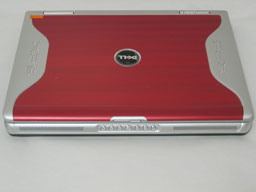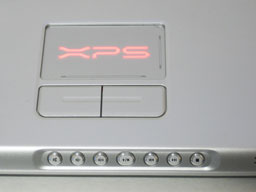Dell XPS M1710 - GeForce Go 7900 GTX 512 Mobile Gaming, Part 1
by Jarred Walton on April 18, 2006 9:00 AM EST- Posted in
- Laptops
Features, Continued
The system that Dell shipped us is essentially maxed out -- the only upgrade you could still make would be to move to 4GB of RAM, but without a 64-bit Operating System you really wouldn't gain much (at least if you're planning on running Windows XP). Since Core Duo processors don't support 64-bit instructions, we'd recommend sticking with 2GB of RAM. Here's the configuration of the system we received for review, with a price of $4200.
To give you a better idea of the layout, we've included labeled images from various angles.

Starting with the front of the unit, you can see the buttons used to control volume and media playback. You can also see the lights behind the speaker grilles, glowing red in this image. The lights on the speakers as well as several other locations around the case can be set to one of 16 colors, or if you prefer you can also turn them off. A glowing XPS logo is also present on the trackpad, but it is limited to a red light. It too can be turned off.

The left side of the unit houses the optical drive, along with two USB ports. The glowing air intake can once again be set to any of 16 colors.

The right side has a 4-pin FireWire port, ExpressCard slot, 5-in-1 flash card reader, and the microphone/headphone audio jacks. Unfortunately, you cannot reconfigure the microphone port as anything but a line-in port, so you're stuck with either 2.1 audio or headphone support. Dell really should have included three audio ports in order to support 5.1 surround sound gaming; maybe next time. The air intake here matches the left side air intake, and both are set to the same color inside the BIOS.

Finishing up with the rear of the unit, we have the majority of the connections. Note that both DVI and VGA display connections are present, which is good considering that most new LCDs use DVI ports. Also present on the rear is an S-VIDEO out port, Gigabit Ethernet, modem, and four more USB ports.
While the above images may help you understand where all of the ports and features are located, their size doesn't do a whole lot for conveying how the system actually looks. This is really a nice looking system, and at least in the notebook market Dell XPS systems are nothing to scoff at. We've included a few more higher resolution images of the system to give you a better idea of what it looks like. (Yes, the trackpad is located slightly left of center.)
The system that Dell shipped us is essentially maxed out -- the only upgrade you could still make would be to move to 4GB of RAM, but without a 64-bit Operating System you really wouldn't gain much (at least if you're planning on running Windows XP). Since Core Duo processors don't support 64-bit instructions, we'd recommend sticking with 2GB of RAM. Here's the configuration of the system we received for review, with a price of $4200.
| Dell XPS M1710 System As Tested | |
| Processor | Intel Core Duo T2600 (2.16 GHz 2x2MB) |
| Chipset | Intel 945PM 64-bit Dual-Channel |
| FSB Speeds | 667 MHz |
| Memory | 2 x 1024MB DDR2-667 SO-DIMM (5-5-5-15 timings) |
| Graphics | NVIDIA GeForce Go 7900 GTX 512MB GDDR3 |
| Display | 17" WUXGA (1920x1200) UltraSharp with TrueLife |
| Hard Drive | 100GB 7200RPM 8MB |
| Optical Drive | DVD+/-RW with Dual-Layer DVD+R Write Support |
| Networking | Integrated 10/100/1000 PCIe Gigabit Ethernet and 56K Modem Intel Pro/Wireless 3945 802.11a/b/g Mini Card Bluetooth Module |
To give you a better idea of the layout, we've included labeled images from various angles.

Starting with the front of the unit, you can see the buttons used to control volume and media playback. You can also see the lights behind the speaker grilles, glowing red in this image. The lights on the speakers as well as several other locations around the case can be set to one of 16 colors, or if you prefer you can also turn them off. A glowing XPS logo is also present on the trackpad, but it is limited to a red light. It too can be turned off.

The left side of the unit houses the optical drive, along with two USB ports. The glowing air intake can once again be set to any of 16 colors.

The right side has a 4-pin FireWire port, ExpressCard slot, 5-in-1 flash card reader, and the microphone/headphone audio jacks. Unfortunately, you cannot reconfigure the microphone port as anything but a line-in port, so you're stuck with either 2.1 audio or headphone support. Dell really should have included three audio ports in order to support 5.1 surround sound gaming; maybe next time. The air intake here matches the left side air intake, and both are set to the same color inside the BIOS.

Finishing up with the rear of the unit, we have the majority of the connections. Note that both DVI and VGA display connections are present, which is good considering that most new LCDs use DVI ports. Also present on the rear is an S-VIDEO out port, Gigabit Ethernet, modem, and four more USB ports.
While the above images may help you understand where all of the ports and features are located, their size doesn't do a whole lot for conveying how the system actually looks. This is really a nice looking system, and at least in the notebook market Dell XPS systems are nothing to scoff at. We've included a few more higher resolution images of the system to give you a better idea of what it looks like. (Yes, the trackpad is located slightly left of center.)
 |
 |
 |
 |
| Click to enlarge | |










69 Comments
View All Comments
timmiser - Tuesday, April 18, 2006 - link
Quieter than my Inspiron XPS version 1.Bluestealth - Tuesday, April 18, 2006 - link
Do they turn off, because that would just get annoying...timmiser - Tuesday, April 18, 2006 - link
Yes. You can change the color and intensity of the lights plus configure the 3 light positions: Speakers/air vents/XPS lid, seperately.The lights are controlled in the BIOS and also in an included Dell windows utility.
JarredWalton - Tuesday, April 18, 2006 - link
Yes, all the lights can be disabled within the BIOS.Patrese - Tuesday, April 18, 2006 - link
Great review, I found the addition of the game tests with sound quite good, just as the inclusion of reference desktop systems for comparison. And the laptop is just awesome...Not that I have the money to buy one of these (not even close, to be honest), but I got curious about the battery life on uses likes web/office. I wonder if the energy saving features can take it a bit closer to the "normal" laptops on that kind of use, since in gaming the 7900GTX certainly needs a lot of juice. And how hot does it get under gaming?
JarredWalton - Tuesday, April 18, 2006 - link
I'll be getting a copy of MobileMark shortly, but I didn't have it in time for the first part. There are quite a few other things I'm going to try to cover in part 2, like potentially turning down GPU performance for longer battery life. Maximum temperatures are warm but not hot - older P4M laptops are all substantially hotter, and even some PM laptops get warmer. The larger size does help with cooling, I would imagine.One43637 - Tuesday, April 18, 2006 - link
i feel sorry for the person that tries to game with that thing on his/her lap. battery life on that thing must be horrendous. good thing it's billed as a DTR.JarredWalton - Tuesday, April 18, 2006 - link
The system gets warm, but not uncomfortably so (for me). I will get some specific numbers for part 2.plewis00 - Tuesday, April 18, 2006 - link
Who games with a laptop actually on their lap? You need a decent mouse anyway and that means a table surely?Rock Hydra - Tuesday, April 18, 2006 - link
I sit on the couch with my Dell 110L in my lap and use the couch cushion next to me as my mousing surface and play games.